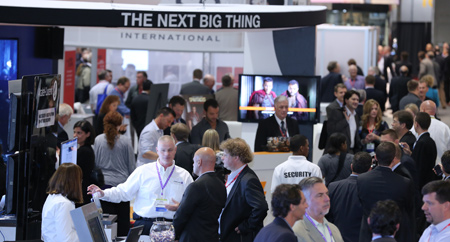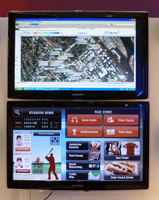Zapping and the Mothers of Innovation is a series looking at innovation at The Cable Show 2012. Written by contributor, Russell Howard.
Busy show floor at The Cable Show 2012.
While walking the floor at The Cable Show, it was abundantly clear to me that the industry is delivering on NCTA’s new advertising campaign: “Cable. It's more than TV. It's how we connect.” The convergence between television and the web continues to accelerate. To some extent, the innovations on display respond to behaviors that have reached critical mass, such as multi-screen viewing. Other innovations are clearly refinements, offering an improved experience of what consumers already embrace. But some innovations are blowing the doors off with immense potential. In particular, cloud based technology could usher in a gold rush of applications like that sparked by the iPhone and iPad. I believe all these innovations have the potential to disrupt business models or consumer behaviors. Here now, in no particular order, is a completely unscientific list of some of the innovations that caught my eye.
- Comcast’s Dayview. There’s been lots of buzz around this virtual dashboard for your life and for good reason. This new interface provides useful and customizable info including traffic, weather schedule, house monitoring, energy use and whatever else consumers need to help run their lives. It’s also smart enough to inter-relate your personal fields and interests to alert you to potential conflicts and opportunities. Given today’s hyper existence I suspect that once people embrace this they’ll wonder how they ever got along without it.
- ActiveVideo’s Cloud TV. There’s no question the forecast calls for “clouds,” which were everywhere you looked around The Cable Show. Cloud-based apps promise the ability to roll out new HTML apps in mere weeks. In many instances, the functionality is executed within the set-top boxes, so not all legacy set top boxes can support it. ActiveVideo says their proprietary technology alone can move the functionality to the network; eliminating the need to replace in-home legacy equipment and permitting operators to offer a consistent experience across their entire footprint. I see a parallel with the game-changing development of Internet Protocol transport, which dramatically reduced the need for interoperable next generation STBs while allowing operators to offer hundreds more networks simultaneously.
- Cisco and the Next-Generation Hotspot initiative.This collaborative industry effort will offer consumers seamless Wi-Fi roaming, analogous to how cell services interlace seamlessly for the consumer. More than just an alternative to a 3G/4G network, it will also extend the cable experience outside of the home: allowing people to pause a movie in the living room and finish watching anywhere there is Wi-Fi. Beyond the convenience, the roaming authentication will also facilitate pinpoint location-based advertising and services as consumers move about. Talk about engagement and potential new revenue.
Cisco's HotSpot demo at The Cable Show 2012
- TiVo To-Go. TiVo, the Kleenex of DVRs with a brand name that stands for an entire category, continues to look to differentiate itself. It says it’s the first to allow consumers to download recorded content to portable devices. That’s a tremendous benefit, but I question the disruptive potential once copyrighted content is converted into portable files.
- Universal Electronics’ Biscotti TV phone. It can turn any TV with HDMI inputs into a video conferencing device, so long as there is a wireless connection. It will allow free calls anywhere around the world, but, unlike Skype, it will interface with Google Talk, Android phones, computers, tablets and soon landlines as well. And because the cable signal passes through the device, you maintain all the TV/DVR functionality during the call. That could be one sweet addition to any bundle, and it’s something DBS can’t offer.
- SeaChange’s Infusion. As it completes its transition to a software-only company, SeaChange is offering a very powerful suite of technologies for advertisers. One of the holy grails of interactive advertising was addressability, which targeted different households with specific messages. This ups the ante by syncing advertising between the TV and other devices being used simultaneously. But then it takes it even further, and allows addressable ads that differ from device to device, targeting the profile of the individual user. If relevance leads to engagement, then this has the potential to offer advertisers premium value.
Clearly, cable is indeed more than TV. It’s how we connect today, and how it will connect us tomorrow in ways we have yet to imagine. But which of these innovations will give rise to unanticipated disruptions? It’s hard to predict, but we can be confident each disruption will be mother to further innovations, and help fuel our industry’s evolution.
*************************************************************************************************************
Russell Howard has more than 25 years of experience in cable and broadcast TV, serving most recently as SVP Communications Worldwide for National Geographic Channels. As VP Marketing & Communications at Team Services, he developed PPV campaigns for WWE, Universal Studios, Paramount Studios and New Line Cinema. Previously, Howard managed news promotion, public relations, and community affairs at KDKA-TV2 in Pittsburgh. Howard got his start in cable creating on-air packaging, promotions and affiliate materials for Cable Video Store, the industry’s 1st satellite delivered addressable PPV network.

